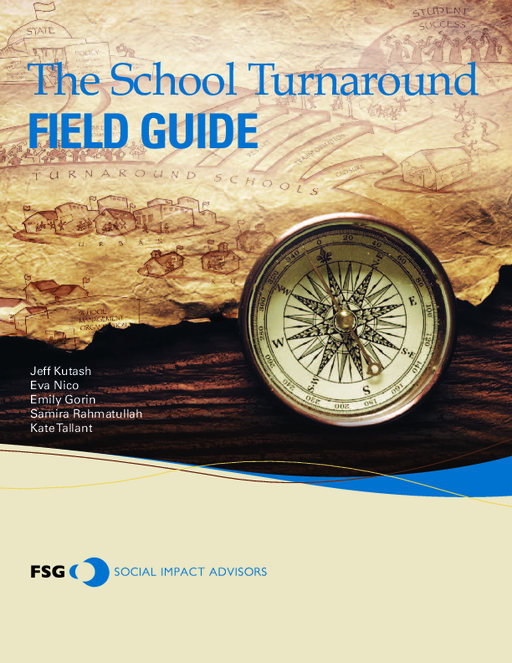Back to Overview
The School Turnaround Field Guide
Table of Contents
- Author(s)
- Jeff Kutash, Eva Nico, Emily Gorin, Samira Rahmatullah, and Kate Tallant
- Publisher(s)
- FSG Social Impact Advisors
Page Count
62 pages
Implementation Tips
The researchers identified important actions for each type of actor:
- U.S. Department of Education: The federal government already plays a key policy-setting and funding role, but can expand its efforts to support more research, rigorous evaluation, and knowledge sharing.
- States: States can focus on developing scalable solutions to human capital and operator capacity issues, creating conditions for success through policy change, assessing the quality of turnaround providers and operators, and investing in the IT and accountability infrastructure that underpins turnaround success.
- Districts: Districts need to create strong talent pipelines, build their accountability and school support capacity, and ensure the availability of critical, high-quality partners, particularly to fill human capital needs and operate schools.
- Unions: Unions can consider turnaround schools as a “laboratory” in which they are more willing to experiment with new types of contracts, new ways of collaboratively partnering with districts, new work rules, and new teacher-evaluation and pay-for-performance approaches.
- School Operators: School operators can scale existing successful models, identify and train turnaround professionals, and build organizational capacity to run turnaround schools.
- Supporting Partners: Supporting partners can build turnaround-specific services. The most pressing need is for greater action from human capital providers. University and alternate-certification programs should focus on developing turnaround-specific training approaches and recruiting and training teachers and school leaders who can drive success in turnaround situations.
- Community-Based Organizations: Community-based organizations (CBOs) focused on parent engagement can mobilize community support for turnaround efforts and the difficult political decisions that often need to be made for those initiatives to succeed. CBOs focused on providing out-of-school-time supports should partner with turnaround schools to improve access to academic and personal support programs that help students catch up academically.
- Research and Field-Building Organizations: Research and field-building organizations are vital to studying and evaluating existing efforts, identifying tools and effective practices, filling important knowledge gaps, and disseminating findings.
- Philanthropic Funders: Foundations can seed innovative models in leadership, teaching, curriculum, support services, community engagement, and other areas vital to turnaround work, as well as invest in partnerships with states and districts in applying these practices at scale.
Topics:

